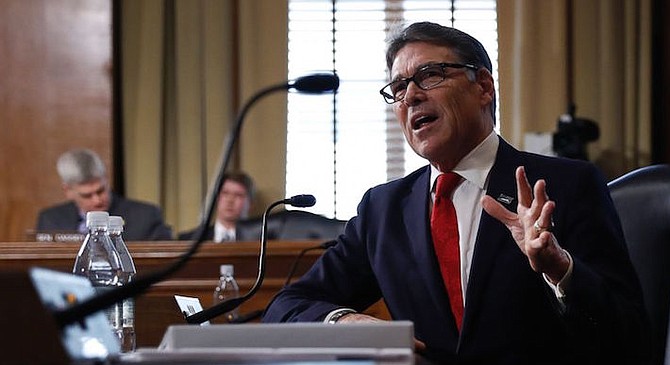 Facebook
Facebook
 X
X
 Instagram
Instagram
 TikTok
TikTok
 Youtube
Youtube

Onetime presidential contender Rick Perry, who famously called for the elimination of the federal Department of Energy before being tapped to lead it, warned on Tuesday (June 20) that conditions at the shuttered San Onofre Nuclear Generating Station could lead to a disaster comparable to 2011's Fukushima-Daiichi nuclear meltdown in Japan.
Citing long-held concerns about the indefinite storage of highly radioactive spent nuclear fuel just 107 feet from the coastline and near several earthquake fault lines, Perry used San Onofre conditions to rally for renewed funding for a long-term nuclear waste dump at Nevada's Yucca Mountain, about 100 miles north of Las Vegas.
"Having those spent fuel rods in those cooling ponds in a region of the world that's inside that 'Ring of Fire,' as they call it — and the potential to have a geologic event — we could have a repeat of what happened at Fukushima to some degree," Perry told House Committee on Appropriations members during testimony defending a White House request for $120 million to restart the licensing process at Yucca Mountain, which was abandoned in 2010.
Locally, activists have been critical of the pools for years. Environmental groups prefer a solution known as "dry cask storage," though this solution is still only feasible for 20 to 40 years. The waste, however, could potentially be toxic for up to 250,000 years.
Despite the ongoing potential for calamity in San Diego and at dozens of other nuclear waste storage sites across the country, any action on a permanent solution is expected to be slow and contested. Both of Nevada's senators have vowed to fight the revival of the Yucca Mountain plan, and even if it does go through construction costs could top $100 billion, which would have to be funded by Congress.


Onetime presidential contender Rick Perry, who famously called for the elimination of the federal Department of Energy before being tapped to lead it, warned on Tuesday (June 20) that conditions at the shuttered San Onofre Nuclear Generating Station could lead to a disaster comparable to 2011's Fukushima-Daiichi nuclear meltdown in Japan.
Citing long-held concerns about the indefinite storage of highly radioactive spent nuclear fuel just 107 feet from the coastline and near several earthquake fault lines, Perry used San Onofre conditions to rally for renewed funding for a long-term nuclear waste dump at Nevada's Yucca Mountain, about 100 miles north of Las Vegas.
"Having those spent fuel rods in those cooling ponds in a region of the world that's inside that 'Ring of Fire,' as they call it — and the potential to have a geologic event — we could have a repeat of what happened at Fukushima to some degree," Perry told House Committee on Appropriations members during testimony defending a White House request for $120 million to restart the licensing process at Yucca Mountain, which was abandoned in 2010.
Locally, activists have been critical of the pools for years. Environmental groups prefer a solution known as "dry cask storage," though this solution is still only feasible for 20 to 40 years. The waste, however, could potentially be toxic for up to 250,000 years.
Despite the ongoing potential for calamity in San Diego and at dozens of other nuclear waste storage sites across the country, any action on a permanent solution is expected to be slow and contested. Both of Nevada's senators have vowed to fight the revival of the Yucca Mountain plan, and even if it does go through construction costs could top $100 billion, which would have to be funded by Congress.
Comments